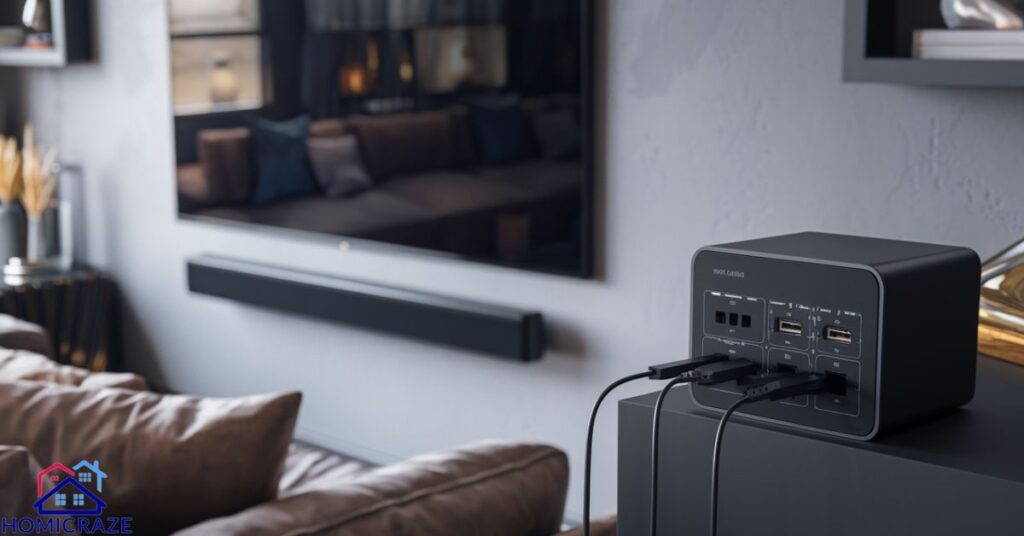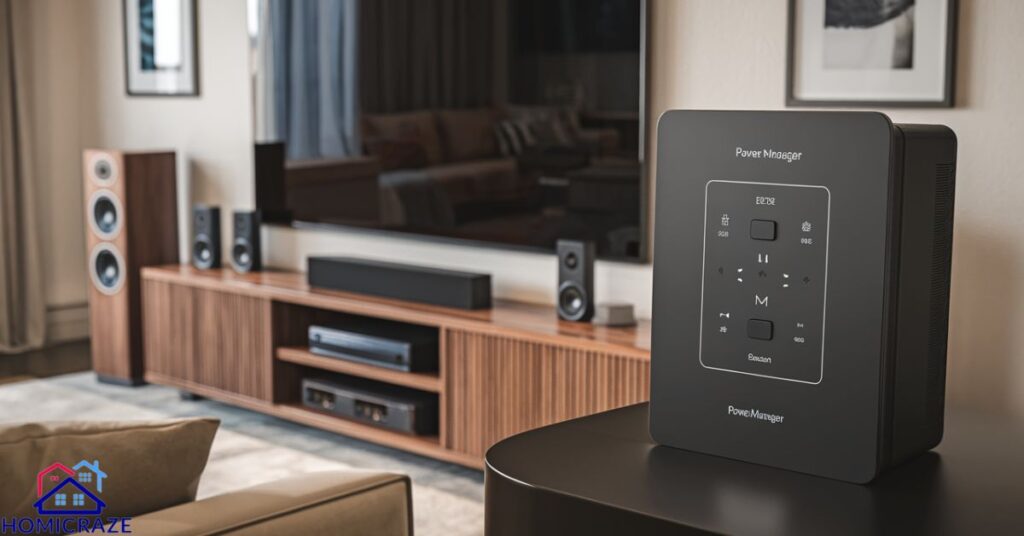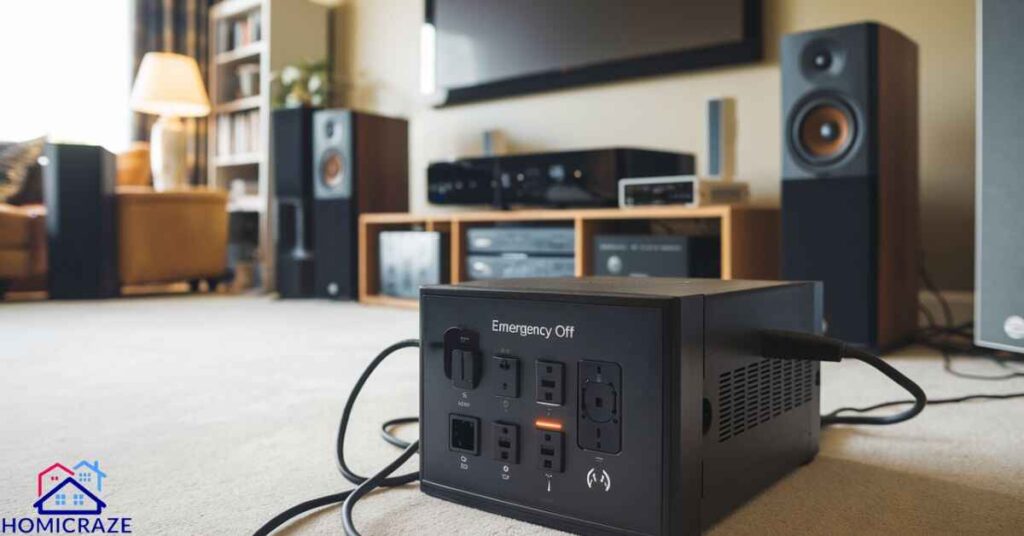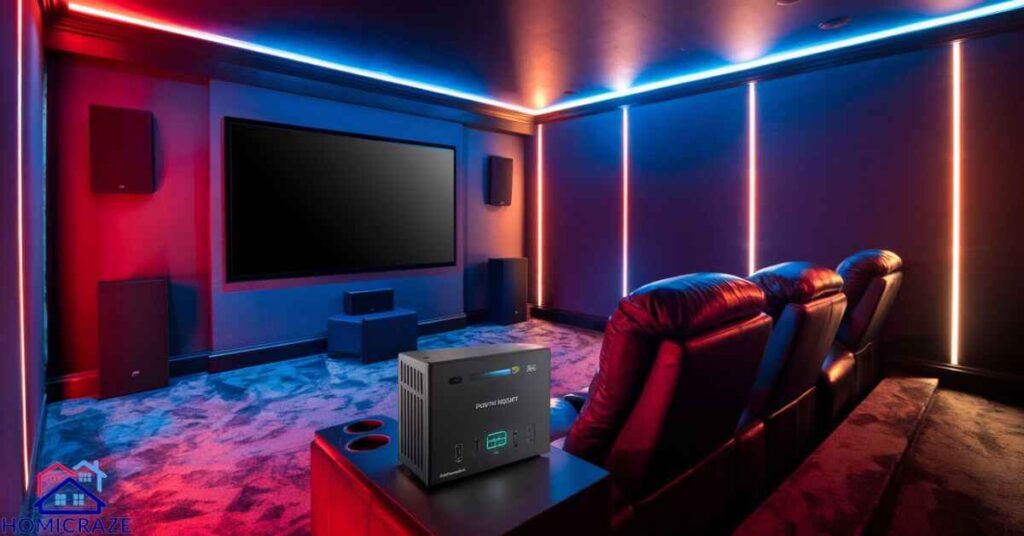Home theatre enthusiasts often face a hidden threat to their prized equipment and viewing experience: dirty power. Voltage fluctuations, electromagnetic interference, and power surges can degrade audio and video quality, shorten device lifespans, and even cause permanent damage.
These issues silently undermine the performance of expensive home theatre setups, leading to frustration and potential financial loss. Enter the home theatre power manager – a specialized device designed to address these power-related challenges.
By conditioning incoming electricity, regulating voltage, and providing robust surge protection, a power manager safeguards your investment and optimizes your home theatre’s performance. This guide explores how power managers work and why they’re becoming an essential component in high-quality home entertainment systems.
What is a Home Theatre Power Manager?

A home theatre power manager is a specialized device for audio-video systems. It’s designed to protect and improve your home theatre setup. Its main job is to clean up the power going to your equipment.
This means it filters out electrical noise and regulates voltage. It also guards against power surges that could damage your devices. Think of it as a bodyguard for your home theatre, keeping it safe and helping it perform better.
The Difference Between Power Managers and Surge Protectors
Power managers and surge protectors may look similar, but they’re quite different. A surge protector is basic protection. It guards against big power spikes. A power manager does much more. It cleans up the power and keeps voltage steady. It also turns on your devices in the right order. Here’s a simple comparison:
| Feature | Surge Protector | Power Manager |
| Surge Protection | Yes | Yes |
| Power Conditioning | No | Yes |
| Voltage Regulation | No | Yes |
| Sequential Power-on | No | Yes |
| EMI/RFI Filtering | Limited | Advanced |
Key Components of a Home Theatre Power Manager
Most home theatre power managers have several key parts. First, there’s the EMI/RFI filter. This removes electrical and radio noise from your power. Next is the voltage regulator. It keeps the power steady, even when your house power fluctuates.
There’s also a surge protector to stop big power spikes. Many have a sequential power-on feature. This turns on your devices in the right order to avoid power surges. Some also include a display to show power info.
Benefits of Using a Home Theatre Power Manager

Using a power manager in your home theatre setup has several advantages. It keeps your expensive equipment safe from power surges. Your audio and video quality improves because the power is clean and steady. Many power managers also help save energy. This can lower your electricity bills over time. Overall, a power manager helps your home theatre system work better and last longer.
Enhanced Audio and Video Quality
Clean power makes a big difference in how your movies and music sound and look. With a power manager, electrical noise is reduced. This means clearer audio without hum or buzzing. For video, you’ll see more stable images with better contrast and color. Pictures won’t flicker or show lines. The result is a more enjoyable viewing and listening experience.
Protection for Expensive Equipment
Home theatre gear can be costly. A power manager acts like a shield for your devices. It stops sudden power spikes that could fry your equipment. It also keeps the voltage steady, preventing damage from power fluctuations. This protection helps your devices last longer. You won’t need to replace equipment as often, saving you money in the long run.
Energy Efficiency and Cost Savings
Power managers can help cut your energy use. Many have features that reduce standby power. This is the power devices use when they’re off but still plugged in. Some power managers also distribute power more efficiently. Over time, this can lead to lower electricity bills. While the savings may be small each month, they add up over the years.
Do I Need a Home Theatre Power Manager or a Power Bar?
Choosing between a power manager and a power bar depends on your setup. Here’s a quick comparison:
| Feature | Power Bar | Power Manager |
| Basic Surge Protection | Yes | Yes |
| Advanced Power Cleaning | No | Yes |
| Voltage Regulation | No | Yes |
| Equipment Protection | Basic | Advanced |
| Energy Saving Features | Rare | Common |
| Price | Lower | Higher |
For most home theatres, a power manager offers better protection and performance.
Limitations of Standard Power Bars
Standard power bars have some drawbacks for home theatres. They offer only basic surge protection. They don’t clean up electrical noise or regulate voltage. This means they can’t improve your audio or video quality. Power bars also don’t have advanced features like sequential power-on. For serious home theatre setups, power bars often fall short in protecting and optimizing your system.
When a Power Bar Might Be Sufficient
A power bar could be enough in some cases. If you have a small, simple setup, it might do. For example, if you just have a TV and a gaming console. Power bars are also good if you’re on a tight budget. They provide basic protection against power surges. For occasional use or temporary setups, a power bar can be a practical choice.
Advantages of Choosing a Home Theatre Power Manager
A dedicated power manager offers more benefits than a basic power bar. It provides complete protection for all your devices. The power conditioning feature improves audio and video quality. Many have energy-saving modes to reduce power use. Some even let you control your devices remotely. For serious home theatre enthusiasts, a power manager is a smart choice to optimize system performance.
Read This Blog: Standard Bedroom Size: How to Create the Perfect Haven?
Are Home Theatre Power Managers Worth the Money?
Deciding if a power manager is worth the cost depends on your setup. If you have expensive equipment, it’s often a good investment. It protects your gear and can improve performance. Over time, it might save you money on energy bills and equipment repairs. However, for very basic setups, the cost might outweigh the benefits. Consider your needs and budget carefully.
Factors to Consider When Evaluating Cost
When thinking about buying a power manager, look at these factors:
1. Value of your equipment
2. Quality of power in your area
3. How much you use your system
4. Your budget
5. Importance of audio/video quality to you
If you have high-end gear or frequent power issues, a power manager is often worth it.
Long-term Benefits and Savings
Using a power manager can pay off over time. It helps your equipment last longer by protecting it from power issues. This means you might not need to replace devices as often. Some users report better energy efficiency, leading to lower electric bills. There’s also less need for repairs due to power-related damage. These savings can add up, potentially offsetting the initial cost of the power manager.
Potential Drawbacks and Considerations
While power managers offer many benefits, they’re not perfect. The main drawback is the upfront cost. Good power managers can be expensive. They also take up space, which might be an issue in small rooms. Some models are large and heavy. In rare cases, they might not be compatible with all devices. It’s important to research and choose a model that fits your specific needs and setup.
Best Home Theatre Power Managers

Several power managers stand out in the market for their quality and features. Top brands include Furman, Panamax, and APC. These companies offer reliable products with good protection and power cleaning. When choosing, look for factors like the number of outlets, joule rating, and filtering capability.
Some popular models are the Furman Elite-15 PFi, Panamax M5400-PM, and APC H15BLK. Each has its strengths, so compare based on your specific needs.
How to Choose the Right Home Theatre Power Manager
Selecting the right power manager involves several steps:
1. Assess your equipment’s power needs
2. Determine your budget
3. Consider the number of outlets you need
4. Check the joule rating for surge protection
5. Look at additional features like voltage regulation
6. Read reviews from other users
Choose a unit that balances your needs with your budget. Don’t skimp on protection, but avoid overpaying for features you won’t use.
Assessing Your Home Theatre Power Needs
To figure out your power needs, start by listing all your equipment. Check the power consumption of each device. You can usually find this info on the device or in its manual. Add up the total watts needed. Also, count how many outlets you need. Consider future upgrades too. This assessment helps you choose a power manager that’s the right size for your system.
Also Read This Blog: Russian Sleep Experiment: Fact or Fiction?
Installation and Setup of a Home Theatre Power Manager
Installing a power manager is usually straightforward. First, choose a good location. It should be easily accessible but not in the way. Make sure there’s good airflow around the unit. Plug the power manager into a grounded outlet. Then, connect your devices to the power manager. Follow the manual for any specific instructions. Some units have different outlets for different types of equipment.
Step-by-Step Installation Guide
1. Unpack the power manager
2. Choose a location near your equipment
3. Plug the power manager into a wall outlet
4. Turn off all your devices
5. Disconnect devices from their current power source
6. Connect devices to the power manager, starting with the biggest power users
7. Turn on the power manager
8. Turn on your devices one by one
Always follow the manufacturer’s instructions for your specific model.
Maintaining Your Home Theatre Power Manager
Regular maintenance keeps your power manager working well. Every few months, check all connections to ensure they’re tight. Clean the unit with a dry cloth to remove dust. Don’t use water or cleaning sprays. Check the display (if it has one) for any warnings or errors. If you hear strange noises or smell something odd, unplug the unit and contact the manufacturer. With good care, a power manager can last many years.
Frequently Asked Question
Can a power manager improve my Wi-Fi signal?
A power manager doesn’t directly improve Wi-Fi signals. However, by reducing electrical interference, it may indirectly help maintain a cleaner signal.
Do I need a separate power manager for each component?
No, you don’t need a separate power manager for each component. One power manager with enough outlets can typically handle all devices in a home theatre setup.
How does a power manager affect my electricity bill?
A power manager can slightly reduce your electricity bill by cutting standby power consumption. The savings are usually small but can add up over time.
Can a power manager eliminate all power-related issues?
While a power manager significantly reduces many power-related problems, it can’t eliminate all issues. It provides excellent protection, but some external factors may still affect your system.
Conclusion
A home theatre power manager is a valuable addition to any serious audio-video setup. It offers crucial protection for your expensive equipment, potentially extending its lifespan and maintaining optimal performance.
By providing clean, regulated power, it can enhance your viewing and listening experience, reducing interference and improving overall quality. While the initial cost might seem high, the long-term benefits in terms of equipment protection, performance improvement, and possible energy savings make it a worthwhile investment for most home theatre enthusiasts.
Meta Description:
How a home theatre power manager protects your gear, improves audio/video quality, and saves energy. Learn why it’s essential for your entertainment setup.







